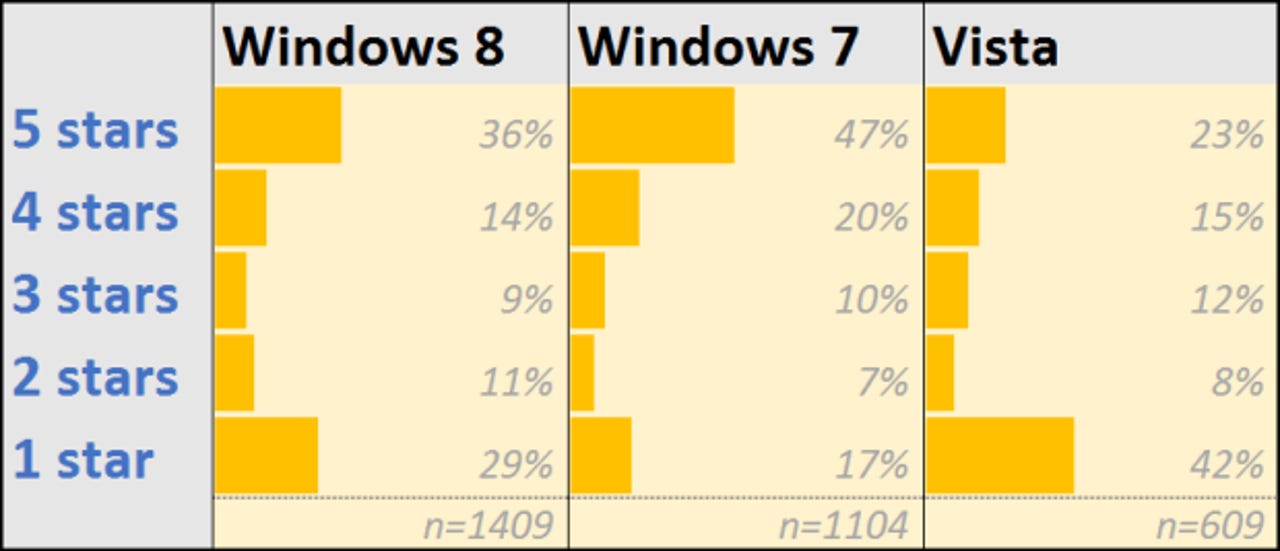Just how much do people hate Windows 8?

Windows 8 might be the most polarizing product that Microsoft has ever introduced.
In fact, it might be one of the most polarizing tech products to ever see the light of day.
There’s no question that Windows 8 has a large number of outright haters. It’s even inspired comparisons with the much-loathed Windows Vista.
But it’s hard to tell whether that outpouring of anger is simply the echo chamber amplifying a vocal minority or whether it truly represents a widespread negative opinion.
So instead of guessing, I went looking for data. And I found it in a familiar place: the product pages of Amazon.com, where thousands of Windows upgraders in the past six years have left ratings (on the familiar scale of 1 to 5 stars) and detailed feedback about their purchase.
I went through more than 3000 ratings for upgrade versions of the three most recent versions of Windows and tallied those ratings to measure the love/hate rating for each one. (For details on methodology, see the end of this post.)
The verdict?
Windows 8 is indeed less popular than Windows 7, which has very high approval ratings. But it’s far more popular than Windows Vista, which was well and truly hated.
Here’s the story, in one easy chart that uses the same format as Amazon’s ratings:

A few conclusions leap off that chart.
In my experience, a 4- or 5-star rating is a solid thumbs-up. A rating of 2 or 3 stars means “Meh.” And a 1-star rating is the equivalent of a raised middle finger. If you read the reviews that accompany 1-star ratings, you’ll find equal parts rage and buyer’s remorse.
By that standard, Windows Vista is a world-class villain, an object of scorn and ridicule, with 42 percent of all reviewers giving it the lowest possible rating.
By contrast, a mere 17 percent of Windows 7 reviewers hated it enough to award it a one-finger salute. And Windows 8 was right smack in the middle of those two, with 29 percent of reviewers giving it just 1 star.
Slightly more than 50 percent all Windows 8 buyers like it. That’s less than the whopping 67 percent approval rating for Windows 7, but far beyond the puny 38 percent of Vista buyers who gave it a thumbs-up vote.
In fact, as a measure of how deeply despised Vista was, note that the number of 1-star ratings was higher than the total of 4- and 5-star ratings. That’s not the case at all with the more recent versions.
The average rating for Windows 7 on Amazon’s 1-5 scale is 3.7. Compare that with the very poor 2.7 rating for Windows Vista. Once again, Windows 8 is right smack in the middle of those two, earning an average rating of 3.2.
For the sake of comparison, I looked at the most recent version of OS X that Amazon sold. Apple sells the newer Lion and Mountain Lion online only, but Snow Leopard, which was released around the same time as Windows 7, is only marginally more popular than its Windows rival. Snow Leopard earns an average rating of 3.9, compared to Windows 7’s 3.7. And, you know, "haters gonna hate.” For the proof, note that 14 percent of Snow Leopard buyers gave the Apple OS a 1-star rating. That's only 3 points lower than the "I hate Windows 7" score.
I suspect that none of these conclusions are surprising to the Microsoft managers and product planners who released Windows 8. They had to know that some of their design decisions were going to be unpopular. People don’t like it when you move their cheese. Time will tell if those customers move elsewhere or slowly come around.
There's certainly precedent for a version of Windows to improve its approval rating over time. I've argued before that Windows 8 and Windows XP share some striking similarities in their initial hostile response (see "Windows 8 is the new Windows XP"). Windows XP might be remembered fondly now, but it took a while for Microsoft customers to feel that love. Here are the ratings from Amazon for the original release of Windows XP and for Windows XP Service Pack 2, which was a major update:
In its initial release, Windows XP wasn't exactly loved, and its overall approval rating at Amazon remained below 3.5 throughout its life. Windows XP's 57 percent total of 4- and 5-star ratings isn't much higher than what Windows 8 is earning today. And the number of haters actually increased slightly with the SP2 update. Like I said, haters gonna hate.
One other encouraging note, from Redmond’s perspective, is that there have been more ratings for Windows on Amazon in the first five months of its existence than Windows 7 has garnered in 3-1/2 years. That suggests a phenomenal level of interest.
If this were a political race, a 50 percent overall approval rating would be a solid base from which to start. In this product category, it indicates a product that needs some attention. Microsoft’s announced plan to release more frequent updates like Windows Blue, due later this year, gives it an opportunity to deal with some of the criticisms. But it’s uncertain whether Windows 8 can ever achieve the popularity of its predecessor, which suggests that Windows 7 will be around for a long, long time.
Notes on methodology: I gathered ratings from Amazon.com on March 31, 2013, for the following products, all in retail boxed upgrade packaging: Windows 8 Pro; Windows 7 Home Premium, Professional, and Ultimate; Windows Vista Home Premium (original and SP1), Business, and Ultimate; and Windows XP Home and Professional (both original and SP2).